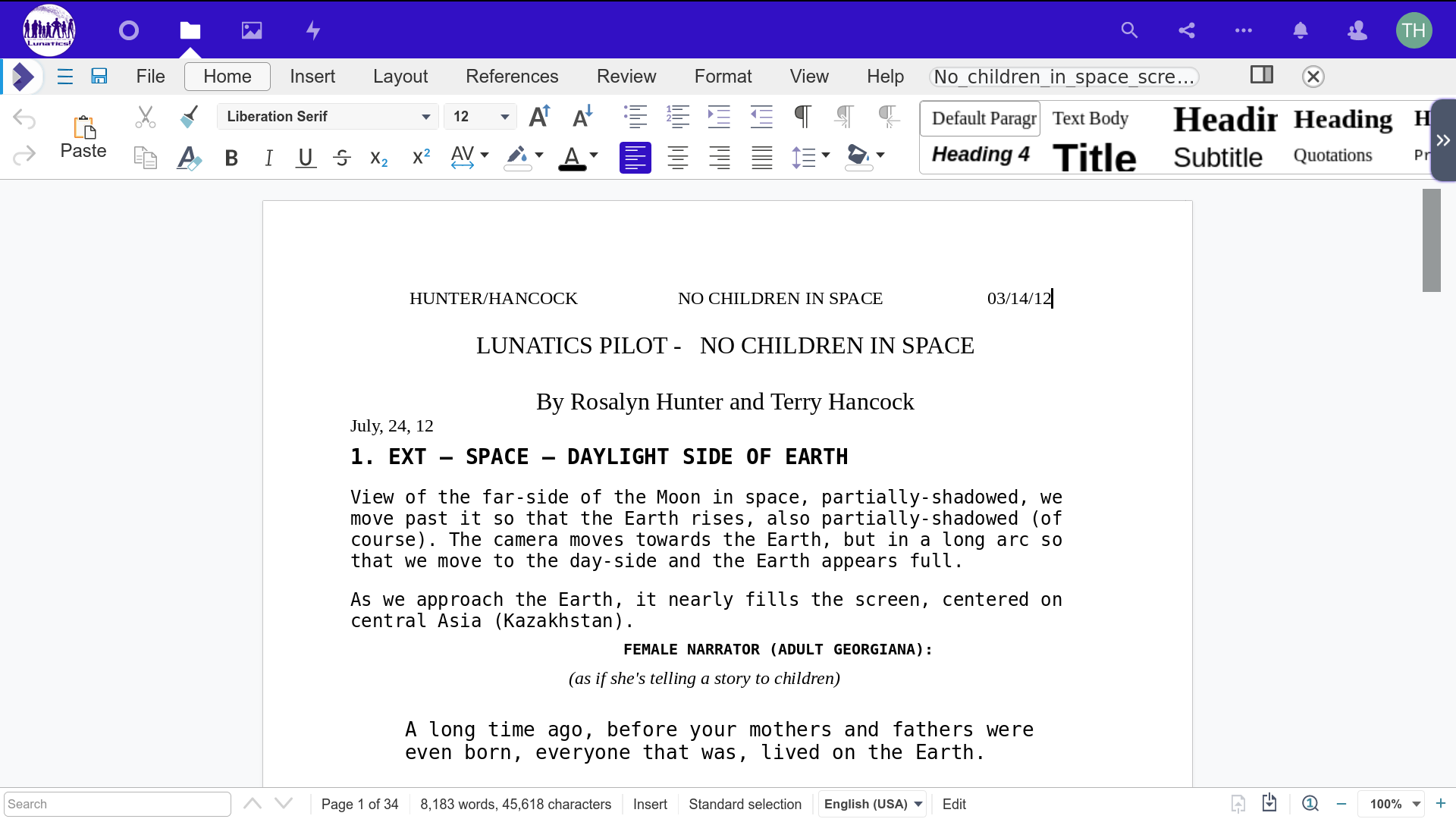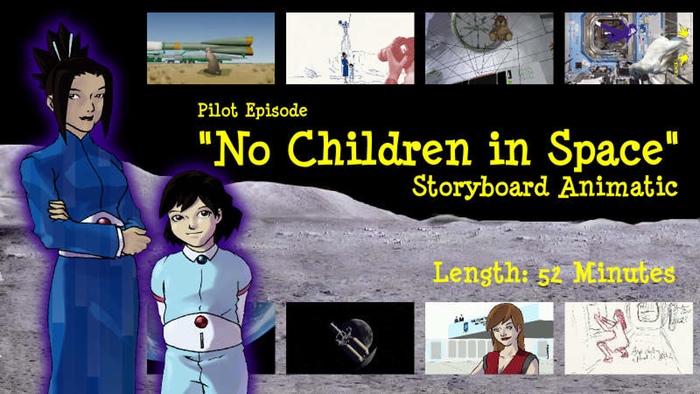Developing the Original Stories for Film
The path we took towards the concept for the pilot episode was pretty convoluted. It arose out of a number of constraints we were trying to deal with when we were planning to launch the “Lunatics!” series. Both “No Children in Space” and “Earth” are drawn roughly from Rosalyn’s original short story, “The Arrival”.
“The Arrival” had several elements of the “Lunatics!” story worked out, although there were quite a few holes, and a lot has been changed since then. One problem with the story was that it introduced all EIGHT of the colonists in one scene in the crawler going to the colony. This is a pretty heavy load for the reader (or viewer), who would undoubtedly have a hard time telling who is who.
But the ensemble cast was an important part of the concept. The original idea was that these were all representative of different factions in the space advocacy community, now working together on the actual frontier.
That presented a story problem, and my suggested solution was that we space out the introductions in some way.
An Hour-Long Music Video
Another problem we had is that, initially of course, we had no voice actors. Since this was a free-culture project in a completely new paradigm and we were basically outsiders to the filmmaking community, I was very concerned that we wouldn’t be able to find any professional actors who’d be willing to work with us. So I was considering the real possibility that the voices — at least in the first version — would just be Rosalyn and I making funny voices. Neither of us is a particularly-skilled actor, and so I felt that a script that relied too heavily on acting would reflect badly on the project.
By comparison, I figured that getting some Blender animation done would be relatively easy, since I had a fair amount of credibility in free-software and free-culture circles, which have strong connections to the Blender community.
I figured what we needed was a demo that would show what we could do with Blender, so that we could then use that to sell the idea to real actors.
So I got the idea initially to create a “demo” video that would just show off this process by taking the viewer from the Earth to the Moon. And I decided that it would be cool to do this in a really visual way, and have the demo driven more by music — that way, if the voice acting was poor (i.e. just us doing voices) then it wouldn’t detract strongly from the film. It had almost no words, and the few that were included were just perfunctory (like the Russian pilot and controller dialog in the trailer) — you didn’t really even have to understand it. This would also mean that the video would work pretty well internationally, since it didn’t rely heavily on language.
In essence, it was going to be an hour-long music video – very artsy. In one slightly later version, we had it so that Georgiana said absolutely NOTHING until the last line “Can I please have some more cake?” The idea was to show that she was nervous through the whole experience, but felt comfortable again when she was finally back in a family setting on the Moon. We substituted that concept with the thread where Georgiana won’t eat until after she arrives.
Exposition: Supply Lines
I also thought it would be kind of cool, as an overall introduction to the series, to take a closer look at the supply-lines that supported the colony. One of my problems with previous attempts to talk about space colonization is that these issues are often skipped over, poorly thought out, and — as a result — the plot seems to be pretty arbitrary about what is or is not easy for the colonists to have.
In 2001, for example, the Moon colony is presented as a small city. There’s food which is clearly highly-processed, implying there’s a factory somewhere on the Moon that makes it. And you have to ask — who’s paying for all that? Is that really how you start out a colony on a new world? Certainly no terrestrial colony has ever been like that — they’ve all had to bootstrap from an
agrarian base. They started with very small groups of farms that cooperated, and industry came only later — even after the Industrial Revolution.
Similarly, the Space Station in 2001 is bigger than a major modern skyscraper in terms of volume — almost a city in itself. There’s probably hundreds or even thousands of people on it. But what do we really have in space now in 2013? We have a much smaller space station with modules in microgravity (no great spinning wheel), and it can handle a crew of about 5-10 people at a time.
So our reasoning was that the very first Moon colony would probably be more like a large homestead with just a couple of families working it to try to make it self-sufficient. And that of course, is what the ISF-1 Colony in “Lunatics!” is (two families and two extra singles with their own separate reasons for being on the Moon).
And these assumptions about the size of the colony, the size and frequency of shipments from Earth, and so on, are critical to writing stories that are accurate and realistic to the setting. It’d be nice to show this off in some way — to prove that, in fact, we had thought all of that through, and thus demonstrate our intent to achieve that level of realism from the beginning of the series. Without that, “Lunatics!” wouldn’t be much more than a “sitcom in space”.
Traveling Into the Future
Visually, I wanted to show that the technology in “Lunatics!” was simply a progression from present-day technology, rather than representing a major break or change. We show space development happening in fits and starts, with the constant intervention of national and corporate politics — just like space development has been since the 1950s.
So I decided to extend this. Rather than having Georgiana and Hiromi fly into Baikonur (which would be a little more conventional), I decided to have them start out on a train — 19th century technology. The explanation for this isn’t hard — it would be one way to avoid being surprised by reporters at the airport — just take the train, and don’t tell anyone. Besides, they would have equipment traveling that way anyway, and it’d be an interesting trip.
Upon reaching Baikonur, we see a city that is a little more developed than today — part of the generally optimistic vision of the future in “Lunatics!”, but the conveyances on the ground would be cars and vans — early 20th century technology. Then, of course, they would ride a Soyuz — one of the longest running middle 20th century spacecraft. And they’d arrive at the Space Station, representing the end of the 20th century.
Georgiana then passes from present-day science fact to science fiction in a barely-noticeable transition as she goes from the “old town” of the present International Space Station, to the “new town” of the newly-extended station in 2040, now known as “Space Station Alpha”. Then, we’d get aboard the wholly-new 21st-century “Lunar Transportation System” moon shuttle, and go to the Moon.
Of course, the price here is breaking one of the cardinal rules of modern science-fiction movie scripts, which is action, action, action, and thus starting in medias res. Instead, I’d be using an old-fashioned, traditional, direct storyline. But then again, this is a story about a child, and it makes some sense to use the simple structure of a children’s story.
So we decided to go ahead and make that definite by sticking a “once upon a time” narration at the beginning — ostensibly by a much-older Georgiana. And that, among other things, establishes a key point about the series — we know they survive to tell the tale (or at least that Georgiana does). And it makes sense that, ultimately, the story of “Lunatics!” would be Georgiana’s story, because she’s the one who is most thrust into events and has to adapt the most — her parents are really just Earthlings on the Moon, but Georgiana is a child, and through the course of the story, will become of the Moon.
Oh But Wait – Actors!
Then I had two huge surprises, which utterly inverted my perception of the problems with making the pilot. First of all, the Blender community was not nearly as friendly to the idea as I had hoped. As I was not an expert Blender animator myself, I was perceived as an outsider — a “suit” — trying to “exploit” them for free labor.
So much for the happy response from a free-software, free-culture-friendly crowd — that was like stepping on a rake! This was not everyone, of course, some people thought it was a cool project, but I did encounter some resistance.
The other thing that happened was that I was contacted by Paul Birchard, who read my column in Free Software Magazine where I was posting about this “bold new experiment in commercial free-culture”. He was interested in the idea, and wanted to be in it. That was extremely cool, and I started thinking about what parts would suit him.
But it also made me rethink my position — maybe the actors wouldn’t be as hard to convince as I thought. I asked for some leads from Paul and from some other friends of mine, and we did a proper casting call and cast the actors for the series. The turnout was amazing — there was actually some significant competition, and we raised our expectations considerably.
At that, we decided to re-write the pilot, and put a lot more dialog into it. This also would give us a chance to do the spaced-out introductions of the main characters that we wanted to do (well, SIX of them — Allen’s and Sarah’s introductions were shifted into separate episodes in the first block, so we could expand on them there).
And thus we adapted to the change. “No Children in Space” became the same story, but with much more dialog and characterization brought into it. Essentially, Rosalyn re-wrote my simple, highly-visual script into something more consistent with what we had visualized for the series.
Children in Space
We’d also been talking a lot about one of the key distinctions in the “Lunatics!” story, which is this idea of a “settlement” versus a “base”. ISF-1 is not the first base on the Moon, we establish that there are several of these in 2040, representing several different organizations: NASA, the US Air Force, a corporate European operation in the northern polar region, and a separate Russian polar research outpost (and possibly more). But these are all functional posts — people go there to work, they don’t really live there.
In fact, when we thought about it, it became clear that the difference was children. If you want to create a true settlement, that means you’re raising children there. As Rob Lerner says in his interview in the pilot, that’s what defines a settlement.
And this is SO contrary to the way existing organizations think about space. Despite having actually promoted the idea in the past, NASA was terrified when the first space tourists were allowed to come up to the International Space Station (probably because of the backlash over the civilian teacher, Christa McAuliffe, dying in the 1986 Challenger accident).
They were so terrified that they tried to stop it, and ultimately the first tourists had to stay on the Russian side of the station — our US socialist space program couldn’t handle Russian capitalism. Ironic, to say the least.
But space is riddled with these kinds of politics. And so it seemed reasonable to me that, for similar reasons, there would be factions who would be livid over the idea of taking a small child into space. And of course, this would be completely antithetical to the goals of colonization and settlement.
So we decided to develop that as a point of tension in the pilot. But it’s a soft tension. This is not an “adventure film” as such, and we also felt that it would be unrealistic to have this played out in a melodramatic way. Instead it would be sublimated in the conversations in the episode.
And On To “Earth”
Most of “The Arrival” is actually the major plot point of what is now the second episode — “Earth”. “No Children in Space” introduces the set-up for the colony and the two main families around whom the story revolves. And that gave us the script that we finally used to create the animatic for the episode, complete with storyboard, some previsualized CG, and voices. Now all we need to do is actually get that Blender modeling andanimation done!



